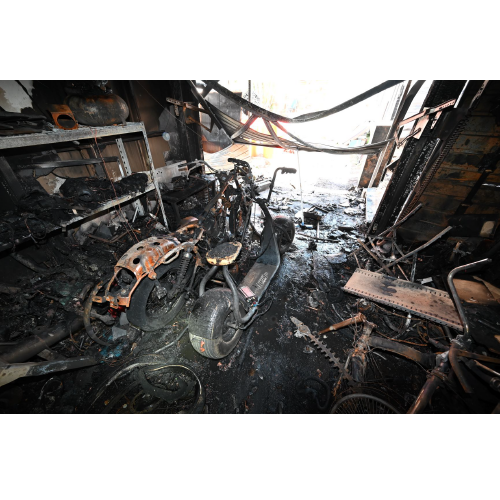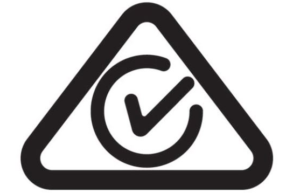
What are lithium-ion batteries?
Lithium-ion batteries are rechargeable batteries that can store more energy in less space than traditional batteries. They are more lightweight and compact than other batteries.
- are common in e-scooters, e-bikes and vapes
- power most household rechargeable devices like mobile phones, laptops, power tools and vacuum cleaners
- come in a variety of shapes, including round (like traditional AA batteries), flat or like a small brick
- usually have ‘lithium-ion’, ‘Li-ion’, ‘li-po’, ‘lithium-polymer’ or ‘Li+’ printed on them.

What are the risks of rechargeable lithium-ion batteries?

The fire behaviour of rechargeable lithium-ion batteries is more volatile than traditional batteries.
If damaged, faulty or charged incorrectly, they can go into ‘thermal runaway’. This means the chemicals in the battery get hotter and hotter, and can’t cool down. The batteries can then catch fire, explode, release toxic and flammable vapour, and reignite when the fire seems to be out.
The risk of fire can increase from:
- Using an incorrect charger (Always use the charger that came with the device when new. Even if a charger fits, that doesn’t mean it’s compatible or safe. Refer to the manufacturer’s specifications to check if the charger is correct.)
- Continuing to charge after the battery is full
- Exposing the battery to heat or moisture
- Using a battery showing any signs of damage (swelling, bulging, leaking, making noises or smelling unusual)
- Tampering with, or modifying, the battery.
Rechargeable lithium-ion battery fires can be volatile
(Video courtesy of Fire and Rescue New South Wales)
How to charge safely
Do:
- Always use the charger that came with the device when new (even if a charger fits, that doesn’t mean it’s compatible or safe. Refer to the manufacturer’s specifications to check if the charger is correct.)
- Always charge devices, especially e-scooters and e-bikes, in a well-ventilated area such as a garage or car port, and on a non-combustible surface (like concrete or ceramic tiles).
- Always let batteries cool down after use and before recharging.
- Charge devices when you are home.
- Charge on hard surfaces like tiles and concrete.
- Have working smoke alarms.
- Disconnect it from the charger once it is fully charged.
- Check that the charger has the Regulatory Compliance Mark
 to show it has met the relevant Australian Standards.
to show it has met the relevant Australian Standards.
Don't:
- Don't leave batteries or devices unattended while charging.
- Don’t charge e-scooters or e-bikes in living areas or where they can stop you from getting to an exit.
- Don’t store batteries or devices in areas where they may be exposed to heat or moisture.
- Don’t charge batteries or devices on or near soft furnishings, like bedding, lounges, carpet or curtains.
- Don’t charge or use a battery or device that is hot or showing signs of damage (swelling, bulging, cracking, leaking, making sounds like popping or hissing, or smelling unusual).
Visit the Electrical Safety Office website for more information about battery and charger safety.
How do I dispose of lithium-ion batteries?
Disposal – damaged batteries
- Contact your local council urgently to ask how these batteries should be disposed of in your local area.
- Lithium-ion batteries with any sign of damage should be treated as damaged and potentially dangerous (particularly if there has been water or liquid in the battery, or exposure to or submersion in saltwater).
- Never dispose of damaged lithium-ion batteries or devices in general household, recycling, public or industrial bins, as damaged lithium-ion batteries can cause fires.
- Do not put discarded, damaged lithium-ion batteries or devices in piles.
- Wear gloves and protective clothing and equipment when handling damaged batteries or devices.
- Be aware of the risks related to damaged lithium-ion batteries, including electric shock, secondary fire risks, and exposure to toxic, corrosive, and flammable vapours and substances.
- Fire or smoke-damaged batteries should be kept outside in a well-ventilated area and stored 10m from any other dangerous goods or materials that are combustible or flammable.
- Place leaking or damaged (but not overheated or off-gassing) batteries in a clear plastic bag or container.
- If safe to do so, damaged lithium-ion batteries may be de-energised before disposal by placing in a large bucket filled with 10 litres of water containing 1 cup of table salt (sodium chloride) for 48 hours. This should be done outdoors in a well-ventilated area.
- If you need to transport damaged lithium-ion batteries or devices refer to the ADG Code for more information on how to package them for transport.
Disposal – undamaged batteries
- Contact your local council to ask how to discard or recycle lithium-ion batteries in your area.
- Never dispose of lithium-ion batteries or devices in general household or recycling bins.
- Never dispose of lithium-ion batteries or devices in industrial bins.
- Do not put discarded lithium-ion batteries or devices in piles.
- Tape over battery terminals with electrical tape before giving them to a disposal or recycling facility.
- Many hardware stores and supermarkets host battery recycling bins, which accept many types of household batteries. Information on battery recycling and safe disposal can be found at https://www.recyclemate.com.au/ or https://bcycle.com.au/
What to do if a fire or emergency occurs – Call Triple Zero (000) immediately if fire or smoke is evident
Fire or smoke
If your lithium-ion rechargeable device is on fire, or smoke is coming from it:
- Evacuate to a safe area and then call Triple Zero (000) immediately.
- Don’t touch a damaged battery or device – severe burns could occur.
- Don’t breathe the air around the battery or device – it will likely contain toxic vapours.
No fire or smoke
If your lithium-ion rechargeable device is creating an unusual smell or sound, developing heat, changing shape or behaving abnormally, and it is safe to do so:
- Disconnect the device from the power supply.
- Move the device outside away from any other combustible items.
- Submerge the battery in a bucket filled with cool water to prevent ignition or further ignitions, until emergency assistance arrives.
Frequently asked questions:
How do I know if my electric scooter meets standards?
Visit the Queensland Government Electrical Safety website for information on how to check if your electric scooter meets standards.
I want more information on Battery Energy Storage Systems (BESS)?
Visit the Queensland Government Electrical Safety website for information about Battery Energy Storage Systems (BESS)
I want to know more about what the Australian Government is doing regarding Li-ion batteries?
The Australian Competition & Consumer Commission has launched a report seeking to demonstrate the importance of safe battery supply and design to support consumer confidence in the safety of Li-ion products.
Where can I recycle my Li-ion batteries?
Information on battery recycling and safe disposal can be found at https://www.recyclemate.com.au/ or https://bcycle.com.au/
Did you know?
A home fire escape plan takes minutes to create and could save you and your loved one’s lives.
New smoke alarm laws are coming January 2027 for home owner-occupiers and caravan/motorhome owners. Don’t wait until it’s too late.
